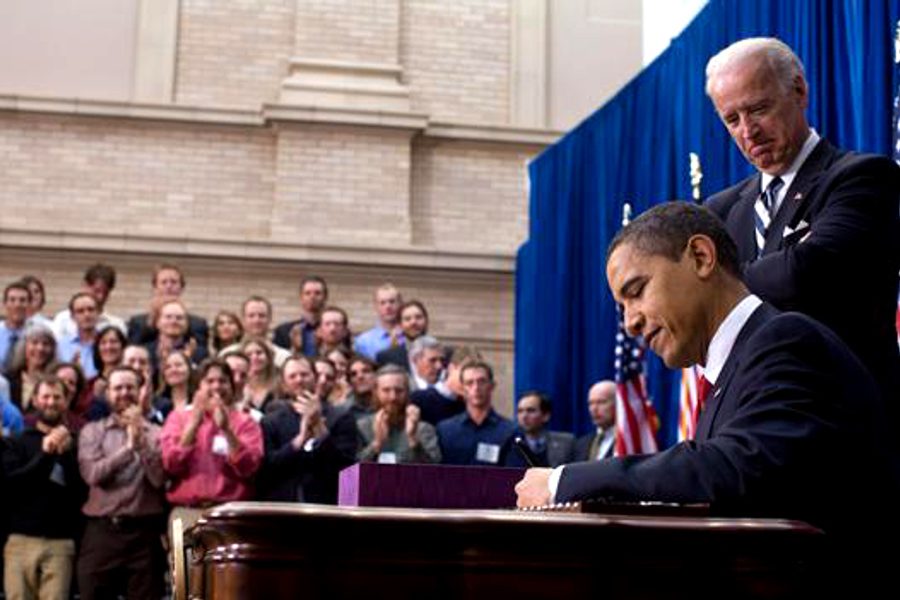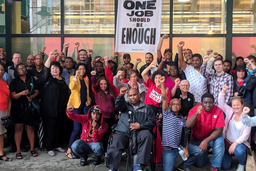
Drawing wide praise from union leaders, President Barack Obama last week signed an executive order designed to crack down on federal contractors guilty of breaking labor law or have compiled excessive workplace health and safety violations. The order was Obama’s third directly related to labor issues in 2014 alone, and the latest in his “Phone and Pen ” campaign to spark administrative changes that would be too difficult to achieve through the normal legislative process.
The July 31 order will establish an elaborate set of new procedures that could be used to punish labor scofflaws in the future by denying these companies new federal contracts. Alternatively, the order could also reward “good” companies with preferential treatment, according to a White House fact sheet. The immediate impact will be minor as the order will not go into effect until 2016, plus the time needed to establish the bureaucratic policies and practices in 14 separate government departments to fully implement the order.
“We feel like the president is doing all the right things,” on labor issues, says Peter Colavito, director of government relations for the Service Employees International Union (SEIU). “The last six or seven months have been terrific,” he says, referring to earlier executive orders raising the minimum wage for federal contract workers and banning workplace discrimination against federal LGBT employees and contract workers. In addition to these orders, a March 13 “Presidential Memorandum” set in motion a revision of Department of Labor overtime rules that is expected to benefit hundreds of thousands of workers by eliminating some of the existing exemptions and anomalies in current overtime regulations.
Obama’s new executive order has also received a shower of praise from the leaders of AFL-CIO, SEIU, International Brotherhood of Teamsters, the United Food & Commercial Workers, United Steel Workers, United Auto Workers, and others. AFL-CIO General Counsel Lynn Rhinehart told Working In These Times the executive order “was a terrific step forward.”
Approval came also from Sen. Tom Harkin (D-Iowa), the Chairman of the Senate Health, Education, Labor and Pensions Committee, who has worked closely with unions over the years on federal contracting issues. Harkin’s statement noted that the executive order drew heavily on recommendations from his own 2013 report detailing widespread labor law violations by federal contractors.
While public praise for Obama was fulsome, some labor officials privately pointed out that the administration’s labor policy goals seem modest. One of the few individuals willing to speak publicly to Working In These Times on this point was Richard Monje, a Chicago-based official of Workers United (an affiliate of SEIU) who served as labor secretary in the “shadow cabinet” of 2012 Green Party presidential candidate Jill Stein. “The problem is less with Obama personally than with the Democratic Party as a whole,” he says. “There is no commitment to a programmatic approach, to a vision to provide jobs for everybody who needs them. Thirty-five years ago, the party was behind the Humphrey-Hawkins full employment bill. Nobody (in the Democratic Party) talks about full employment anymore.”
Executive orders and presidential memorandums, while welcome, have the inherent weakness of being only temporary, Monje continues. Obama’s recent actions would almost certainly be reversed if a Republican president is elected in 2016, or become irrelevant if a Democratic successor to Obama chooses to further de-emphasize labor and employment issues, he points out. “If the Democratic Party is not going to speak for workers, then we need an independent voice,” Monje says.
Coalvito says he agrees that executive orders are a poor substitute for new legislation. “Believe me, we’re deeply aware how transient these things can be if the wrong candidate is elected [in 2016],” he says. “The upside is that there are two-and-a half years yet to go in Obama’s term, so that’s enough time to implement,” some of his proposals, particularly the minimum wage and anti-LGBT discrimination provisions for federal workers, he says.
The labor scofflaw order, however, is a larger administrative undertaking and has a long history of determined opposition, one Washington veteran told Working In These Times. In the mid-90s labor unions pushed hard to get the Clinton administration to act against labor scofflaws (especially Avondale Shipyard, a major military contractor that was in the midst of a tough union organizing fight at the time) and were able to get the DOL to begin the work of reforming contracting practices. The work was delayed by opposition from pro-business lobbyists, and then abandoned entirely when George W. Bush became president in 2001, the veteran recalls.
The progress of Obama’s executive order on labor scofflaws will depend almost entirely on the energy and skill employed by Labor Secretary Thomas Perez over the remainder of Obama’s term of office, Colavito offered. “And that’s a good thing. There is no question he has made a difference in the short time he has been there,” he says.

I hope you found this article important. Before you leave, I want to ask you to consider supporting our work with a donation. In These Times needs readers like you to help sustain our mission. We don’t depend on—or want—corporate advertising or deep-pocketed billionaires to fund our journalism. We’re supported by you, the reader, so we can focus on covering the issues that matter most to the progressive movement without fear or compromise.
Our work isn’t hidden behind a paywall because of people like you who support our journalism. We want to keep it that way. If you value the work we do and the movements we cover, please consider donating to In These Times.






